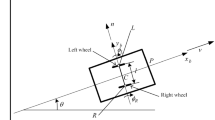Abstract
This paper addresses the path planning problem for autonomous mobile robots operating in an unknown environment with obstacles. Paths are formed based on third-order Bezier splines and, then, are corrected on the move as a robot detects obstacles with its onboard sensors. During this correction, the initial path between two reference points is divided into two segments (described by Bezier splines) in such a way as to allow the robot to move at a safe distance from a detected obstacle along a smooth resultant trajectory. In this case, the use of smooth paths ensures a high levels of accuracy and velocity of mobile robots during their operation.
Similar content being viewed by others
References
T. I. Fossen, Handbook of Marine Craft Hydrodynamics and Motion Control (Wiley, Chichester, 2011).
B. Siciliano and O. Khatib, Handbook of Robotics (Springer, Berlin, Heidelberg, 2008).
V. F. Filaretov and D. A. Yukhimets, “Synthesis of a system of automatic calculation of program signals for controlling motion of an underwater vehicle along a complex spatial trajectory,” J. Comput. Syst. Sci. Int. 49, 96 (2010).
V. Filaretov and D. Yukhimets, “Synthesis method of control system for spatial motion of autonomous underwater vehicle,” Int. J. Ind. Eng. Manage. 3, 133–141 (2012).
V. Filaretov and D. Yukhimets, “The synthesis of system for automatic formation of underwater vehicle’s velocity, in Proceedings of the 20th International DAAAM Symposium on Intelligent Manufacturing and Automation: Focus on Theory, Practice, and Education, Vienna, Austria, 2009, pp. 115–1156.
V. F. Filaretov and D. A. Yukhimets, “A method for forming program control for velocity regime of motion of underwater vehicles along arbitrary spatial trajectories with given dynamic accuracy,” J. Comput. Syst. Sci. Int. 50, 673 (2011).
M. Robin, Introduction to AI Robotics (A Bradford Book, Massachusetts, 2000).
T. Jianping and S. Yang, “Genetic algorithm based path planning for a mobile robot,” in Proceedings of the IEEE International Conference on Robotics and Automation, Taiwan, Taipei, 2003, Vol. 1, pp. 1221–1226.
N. Shiltagh and L. Jalal, “Path planning of intelligent mobile robot using modified genetic algorithm,” Int. J. Soft Comput. Eng. 3 (2), 31–36 (2013).
K. H. Sedighi, K. Ashenayi, T. W. Manikas, R. L. Wainwright, et al., “Autonomous local path-planning for a mobile robot using a genetic algorithm,” in Proceedings of the Congress on Evolutionary Computation, Portland, USA, 2004, Vol. 2, pp. 1338–1345.
L. Wangy, L. Yongy, and H. Marcelo, “Hybrid of global path planning and local navigation implemented on a mobile robot in indoor environment,” in Proceedings of the IEEE International Symposium on Intelligent Control, Vancouver, British Columbia, Canada, 2002, pp. 821–826.
Zh. Wu and L. Feng, “Obstacle prediction-based dynamic path planning for a mobile robot,” Int. J. Advancem. Comput. Technol. 4, 118–124 (2012).
N. Shiltagh and L. Jalal, “Optimal path planning for intelligent mobile robot navigation using modified particle swarm optimization,” Int. J. Eng. Adv. Technol. 2, 260–267 (2013).
S. Garrido, L. Moreno, D. Blanco, and P. Jurewicz, “Path planning for mobile robot navigation using voronoi diagram and fast marching,” Int. J. Robotics Autom. 2, 42–64 (2011).
T. Mohanraj, S. Arunkumar, M. Raghunath, and M. Anand, “Mobile robot path planning using ant colony optimization,” Int. J. Res. Eng.Technol. 213 (11), 1–6 (2013).
S. Ge and Y. Cui, “Dynamic motion planning for mobile robots using potential field method,” Auton. Robots 13, 207–222 (2002).
J.-H. Zhou and H.-Y. Lin, “A self-localization and path planning technique for mobile robot navigation,” in Proceedings of the 8th World Congress on Intelligent Control and Automation, Taiwan, Taipei, 2013, pp. 694–699.
V. F. Filaretov, D. A. Yukhimets, A. F. Shcherbatyuk, E. Sh. Mursalimov, and I. E. Tufanov, “The method of tracking control of autonomous unmanned underwater vehicle motion,” Mekhatron., Avtomatiz., Upravl., No. 8, 46–55 (2014).
C. de Boor, A Practical Guide (Springer, New York, 2001).
Author information
Authors and Affiliations
Corresponding author
Additional information
Original Russian Text © V.F. Filaretov, D.A. Yukhimets, 2017, published in Izvestiya Akademii Nauk, Teoriya i Sistemy Upravleniya, 2017, No. 4, pp. 174–176.
Rights and permissions
About this article
Cite this article
Filaretov, V.F., Yukhimets, D.A. Planning smooth paths for mobile robots in an unknown environment. J. Comput. Syst. Sci. Int. 56, 738–748 (2017). https://doi.org/10.1134/S1064230717040098
Received:
Accepted:
Published:
Issue Date:
DOI: https://doi.org/10.1134/S1064230717040098




